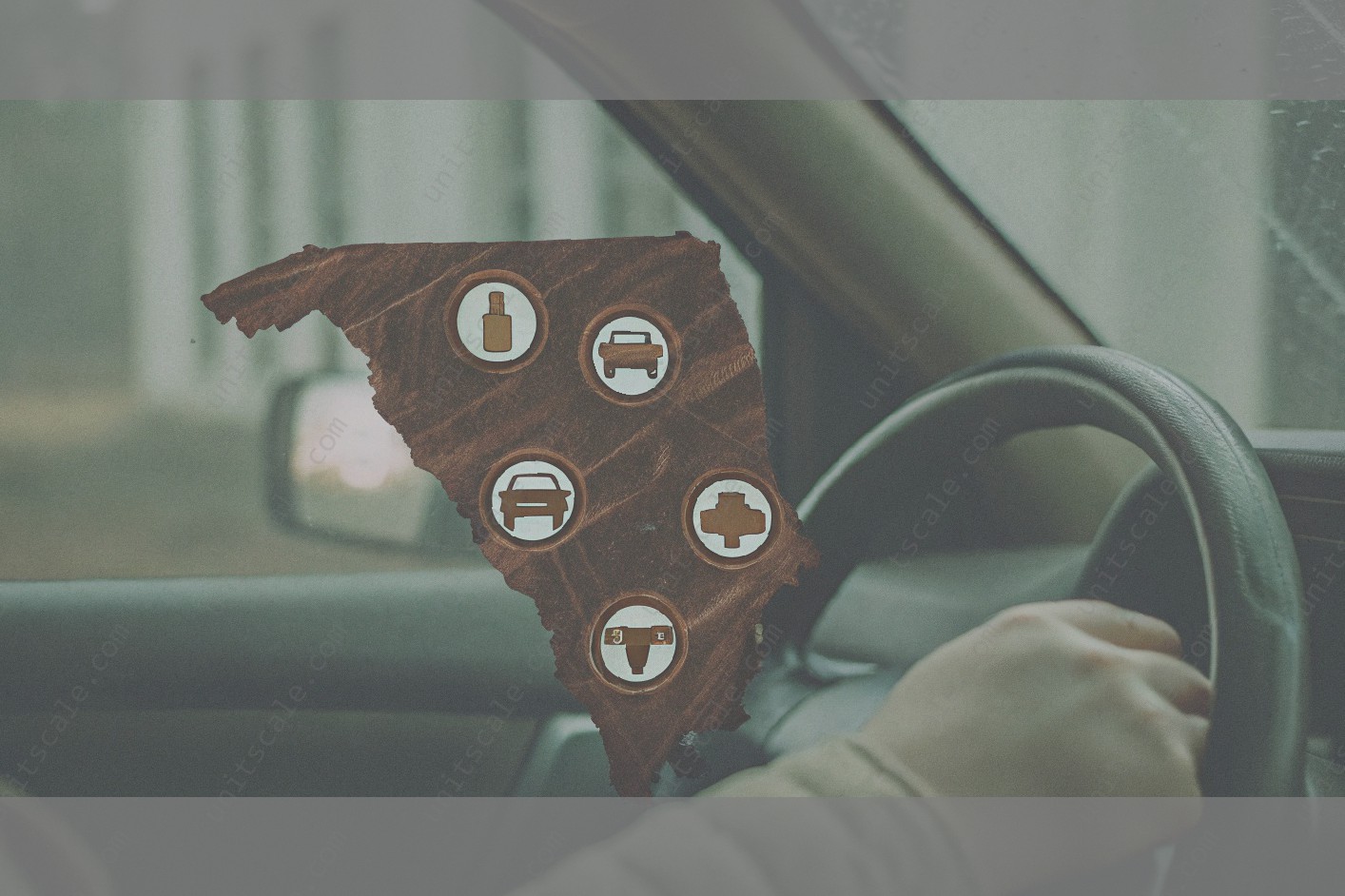Current Legal Alcohol Limit in SC
Blood Alcohol Concentration (BAC) limits in South Carolina differ based on the age of the driver. For drivers over the age of 21, the BAC limit is currently .08%. The average drinker would need to consume six beers in an hour to reach that number. For drivers under the age of 18, the BAC limit is reduced to .02%. This limit was introduced as part of the Zero Tolerance Law. For commercial drivers, the BAC limit is . 04%. If a commercial driver is convicted of a DUI with a BAC of .15% or higher, they may be charged with aggravated DUI. In South Carolina, you can be charged with a DUI without blowing a .08%, but rather merely by driving poorly. In this way, South Carolina law enforcement is relying on the officer’s observations and not on the results of a breath test to obtain a conviction.

Penalties for Going Over the Legal Limit
Exceeding the legal alcohol limit set forth in South Carolina law can result in severe and sometimes harsh penalties. Sentences often become harsher depending on the nature of the crime, so it is always a good idea to look for a lawyer who is focused on these matters.
Fines
You may face substantial criminal fines if you are charged with a DUI in South Carolina. Fines are determined by the level of offense. They range from $400 to $5,100. The following is a basic outline of fines and other penalties:
Partner: A person convicted of first offense driving under the influence will receive the following penalties:
1st: Five hundred ($500) dollars and up to a fine not to exceed ten thousand ($10,000) dollars.
2nd: Seven hundred fifty ($750.00) dollars and up to a fine not to exceed ten thousand ($10,000.00) dollars.
3rd: One thousand ($1,000.00) dollars and up to a fine not to exceed ten thousand ($10,000.00) dollars.
4th or Subsequent: An amount to be determined by the court but not less than five hundred dollars ($500.00) nor more than ten thousand ($10,000.00) dollars.
The good news is that if your fines are higher than average you can often work out a payment plan. Be aware that this is not always the case.
Jail Time
First and second offense DUI convictions range anywhere from 48 hours to three years. Basically, the more experience you have on your record, the longer the sentences tend to be. A third offense can result in a minimum of 60 days in jail. For your fourth offense and beyond, prison time is likely. First offence convictions are often given a suspended sentence if the perpetrator goes through rehab. However, repeat offenders face penalties even more significant than those described above.
License Suspension
All DUI convictions result in license suspension. Additional factors will lead to additional suspensions.
Drug Tests
Refusing a drug test is punishable as if you were guilty of the DUI charge. Therefore, people are strongly encouraged to submit to a blood or breathalyzer test when requested by police to avoid further complications.
Other Consequences
All DUI convictions result in points against your license. As a result of obtaining too many points you will be required to take country-specific driver safety classes. This can be an inconvenient process.
Long-term ramifications of a DUI conviction can include problems with employment and housing. These issues can be explained away in some situations, but they may cause more problems than the average person expects.
BAC Measurement in SC
South Carolina law enforcement authorities use various methods to determine a person’s BAC. Law enforcement officers have the technology to measure BAC in the field using breath alcohol tests and field sobriety tests. More definitive results can be obtained from laboratory testing. Each of these methods has its pros and cons, but are all used for the same purpose: to estimate BAC.
Field Breath Testers
Breath analysis machines are usually known as Drager Alcotest 7110mkIII-C, or as Datamaster DMT II. They are often called "breathalyzers" by officers and other persons. They measure the amount of alcohol on your breath in the air that you exhale. This is known as a breath test. The assumption is that the ethanol alcohol on your breath comes from alcohol that has been absorbed into your blood stream. Breath tests show if alcohol is present in breath at the time the test is administered. Because the BAC will increase after drinking stops if alcohol has already entered the body through the stomach, the BAC level shown in the test may not be the one that existed if the arresting officer had waited a little longer to ask for the breath test.
The BAC reading is shown on the printed out results of the test after the test is administered. If the reading is .08 or higher, it is considered prima facia evidence that the driver was under the influence of alcohol. The statutes also presume that a BAC result .08 or greater establishes a violation of the law.
Accuracy of the results generated in the field can be compromised by many things, such as an improperly calibrated machine or one not connected properly. Wet or dirty mouths can cause elevated readings due to mouth alcohol. The breathalyzer will predictably produce higher results if mouth alcohol is present. The effects of smoking, disease processes, and medications on the accuracy of breath test results is not completely known. However, the indications are that these factors can result in falsely low or high results.
Field Sobriety Tests
Field sobriety tests (FSTs) can also called roadside tests. They are usually requested after an officer suspects someone is under the influence of drugs or alcohol. The roadside tests include 1-leg stands, reciting the alphabet, counting out loud, following lights or objects, walking heel to toe and other tests. Some of these tests require the exercise of divided attention, the ability to perform more than one task at a time. If an officer requests these tests it will be after observing physical signs of impairment. These signs could include your bloodshot or glassy eyes, poor or slurred speech, odor of alcohol, difficulty in understanding what the officer is saying, and other things. Take my advice—don’t be fooled into taking roadside tests. They are subject to many things that can make the results unreliable. This is especially true if you have worked long shifts with little rest, taken medications, have other health issues, or are distracted by the officer’s presence.
Tips to Avoid Exceeding the Legal Limit
When it comes to understanding the legal blood alcohol limit in South Carolina, there are some tips you should keep in mind in order to avoid a citation as an impaired driver.
Keep track of how many drinks you have: The easiest way to determine if you are over the limit is to measure your drinks. Pour your own drinks, and use the same measuring glasses for each drink you are pouring. A "typical" drink should contain about .54 ounces of alcohol, equivalent to a 12 ounce beer, 5 ounce glass of wine, or 1.5 ounces of liquor.
Use a designated driver: When you are driving you should not consume even one alcoholic beverage. Therefore, you should hang up your car keys whenever you decide to have a drink. Consider taking public transportation, getting a cab, or taking an Uber and having a sober friend or family member pick you up. Failing to do so could not only hurt someone else or yourself but also cost you thousands of dollars in fines and fees, or even jail time, if you are stopped by law enforcement while impaired.
Get a breathalyzer app: Breathalyzers are available on your smartphone for free. Although you may be unable to determine your exact blood alcohol content, the app will let you know if your blood alcohol level might be illegal. However, remember that these devices are not 100% accurate and results may not be flawless.
Of course the best way to avoid being in violation of the blood alcohol limit law is to not drink and drive. If you do drink, always use a designated driver – or at the very least a taxi, Uber or Lyft.
Changes to SC Alcohol Laws
A growing issue surrounding the legal limit has been legislative debate on whether or not to lower the legal blood alcohol limit here in SC from .08 to .05. The movement comes primarily from Mothers Against Drunk Driving (MADD). However, opposition to the change in the law is notable as well.
On May 5, 2016, MADD submitted a proposal to SC legislators calling for the lowering of the legal limit to .05 from .08. Their argument is that lowering the limit would help reduce the number of drunk driving fatalities. The proposal states that this change would "save 66 lives in South Carolina."
This proposal comes after the Southern Christian Leadership Conference (SCLC) passed a resolution earlier this year that called for the legal limit to be lowered from .08 to .05. One in favor of this proposal is SC Senator Brad Hutto, the Chairman of the Senate Judiciary Committee’s Subcommittee on Criminal Justice. "South Carolina is still over the national average in drunk driving cases," he said. "If we can take [the limit] to .05, I’m sure we will save some lives. I think that is something we ought to do." Harrison testified in support of the bill at the SC House of Representatives Judiciary Committee hearing last year. He backs the proposal because of the safety it portends, although legislative movement or support is unclear. "I have seen so many people killed because people have not been responsible, and this .05 law would have saved them," Harrison said.
The SC Department of Public Safety (DPS) recently released its FY 2013-2014 annual report stating that drinking and driving arrests dropped 8.9% from the previous year. However, MADD South Carolina is not impressed with the reduction. "It’s not enough. We have a long way to go," said State Executive Director Erin O’Neal Cook of MADD South Carolina, who blames African Americans and Native Americans for the increase. "We know that African American communities are disproportionately affected by drunk driving in terms of fatalities, and Native Americans are disproportionately affected when you look at the population size. So we really need to have a focused effort on those communities to address the drinking-and-driving problem that exists there . "
Although declining alcohol consumption has been reported by other groups, DPS Spokeswoman Sherri Iacobelli cautions against brushing aside the problem. "…We’ve seen a decrease in alcohol consumption across all age groups," she said. "There’s a lot of competition for what people spend their money on, especially young people, but there is still a problem with drunk driving in South Carolina," she said. "When you look at the records, particularly of our fatalities, alcohol is a factor. Our alcohol-related fatalities for the first six months of 2014 were 55 percent or higher and still remain over 50 percent of the total."
Drunk driving advocates argue that the legal alcohol limit should be lowered in order to reduce fatalities and alcohol-related problems. While others argue that drinking and driving issues are declining in South Carolina, and that we do not need to lower the legal limit, which will only hurt those who have been responsible alcohol consumers and do not endanger themselves or others. "The fewer deaths, injuries or property damage caused by alcohol-related traffic crashes, the more likely they are to be attributed to fewer people who are driving under the influence of alcohol at the time of the crash," said Jeremy Taylor, a researcher at the Governors Highway Safety Association (GHSA).
A very small percentage (29%) of drivers involved in fatal crashes had a blood alcohol concentration. And that number has been on a slow decline since 1998. It is lower than the national average (35%). A much higher percentage of SC road users are at risk of alcohol-related traffic crashes because more are driving under the influence, versus being killed due to alcohol-related traffic crashes. The GHSA reports that 1.1% of SC road users in 2012 were involved in a traffic crash where there was an alcohol violation by a driver. That is the 3rd highest rate in the nation, behind only Montana and Michigan. The Governor’s Highway Safety Association has no official opinion on the lowered legal alcohol limit proposal, and would not speculate on the political factors involved in the matter.
Effects of Alcohol on the Roads
The relationship between legal alcohol limits and road safety is a topic of considerable debate. In South Carolina, the legal limit for blood alcohol concentration (BAC) is currently set at 0.08 percent. Numerous studies have shown a direct correlation between the reduction of BAC limits and the lowering of alcohol-related traffic offenses and fatalities. According to the National Highway Traffic Safety Administration (NHTSA), states that have enacted lower BAC limits have seen a substantial decrease in the number of crashes resulting from drunk driving. For example, a report by the NHTSA found that states that adopted a 0.08 percent BAC limit experienced a decrease in fatal crashes by an average of 7 percent.
Furthermore, a 2015 study published in the journal Alcoholism: Clinical & Experimental Research analyzed data from 29 states and the District of Columbia, finding that among all drivers, the adoption of the 0.08 percent BAC limit was associated with a significant decline in fatal crashes. The study estimated that the reduction in fatalities could be attributed to over 27,000 fewer alcohol-related traffic deaths from 1997 to 2006. This finding is in line with a National Institute on Alcohol Abuse and Alcoholism report from 2005 which found that a reduction in the legal BAC limit saved more than 2,000 lives.
A separate investigation published in the American Journal of Public Health compared BAC limits and fatalities in states with primary enforcement legislation (vs. secondary enforcement laws) in combination with a 0.08 percent BAC limit. The researchers found that states that had both types of laws combined saw a greater reduction in fatal crash rates than states that only had one or neither law. These studies suggest that there is a distinct relationship between BAC limits, enforcement laws and road safety.
In light of this data, South Carolina’s efforts to raise the intoxication level to a BAC of 0.10 would seem to counteract the objective of reducing accidents on the road.
Legal Help with SC DUI Charges
If you are arrested for drunk driving in South Carolina, it is vital to understand your options regarding the legal limit and how the charge may play out in court. First, you should be aware that there are two general charges for DUI in the state: driving with an unlawful alcohol concentration (DUAC) and driving under the influence (DUI). A moving violation such as speeding or erratic lane changes may enable an officer to lawfully stop your car. After a falsified profile is established, the officer may then have probable cause to require you to submit to an alcohol breath test. However, the results of the BAC test can be contested. Even if your breath test BAC was .08 or higher, you might be able to avoid conviction. A driver can be charged with DUI when a breathalyzer result is below .08 if other behaviors indicated that the driver was intoxicated . Factors to consider are whether you refused to take a chemical test, if there is a car accident in which someone was hurt and whether there was a child passenger in the vehicle. For DUI offenses, the minimum legal blood alcohol limit in South Carolina is .08. There are further penalties for underage DUI offenses in South Carolina. Drivers 20 years old and younger who are arrested for driving under the influence, but have a BAC below .08, can still face criminal penalties, including 48 hours to 30 days in jail and fines of up to $300 plus 48 hours of community service. A DUI in South Carolina will have serious repercussions that will impact your life for many years. Not only can you face fines, license suspension, and possible incarceration, you could also have to pay for the legal representation you hired to defend you in court, especially if you need a specialist in drunk driving laws. You should always consult with a lawyer who has experience in handling DUI cases in South Carolina to maximize your chances of success.


